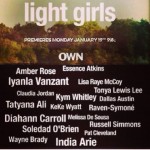By EMERY CHILDS
Oprah Winfrey’s documentary “Light Girls” proves self hate has no color.
“Light Girls” tells the chilling story of how color-ism came to existence, how it affected modern society and why it just won’t go away.
The film, released Jan. 19. explores the concept of color-ism within the black community and on a international scale. The form of the documentary features an open forum discussion. Through this format, countless celebrities, doctors and even children share their perspective on the color complex, and how its ignorant standards still pervade daily life.
The sequel to “Dark Girls,” “Light Girls” depicts a naked truth that is only talked about at your mothers kitchen table. The film ripped the band-aid off of the wound that hasn’t healed since slavery.
Written by Bill Duke with narration by Iyanla VanZant ,the documentary features journalists, physiologists, doctors, and many familiar faces from “Black Hollywood,” both new and old who identify as Black.
Although it’s often thought of as a prominent issue in the Black community,quietly judging people based off their hue has been going on for centuries. For example, Japan’s bleaching epidemic had viewers cringing. India’s obsession with fair-skinned men and women suitors had spectators in total disbelief.

The documentary ‘light girls’ was released Jan.20. PHOTO/Emery Childs
The documentary puts the color-ism stereotype to rest. This film discusses the sensitive issue by breaking down the history of color-ism, understanding its role in many of life experiences, such as dating, media influence and race relations.
One valuable perspective is that of former Fresh Prince of Bel-Air actress, Tatianna Ali. She goes into depth about color-ism in the entertainment industry. She says, “There is safety in being able to categorize a person. You can assign all of your preconceived ideas about who is person is, the type of person they are, what kind of behavior you expect from them-only if you know “what” they are.” Her truth speaks for all too many. America isn’t the only place to have such ridiculous standards of beauty.
Discussions of India’s obsession with fair skin arise next. In some Indian societies full blooded Indians with fair skin are seen as “the top on the tarp” said journalist Sharon Carpenter who is half Indian herself. In their society lighter skin implies that your “classier”. This phenomenon really comes to the surface when they discuss dating. Nina Nannar says that the last two pages of their Asian magazine are devoted to advertisements made by parents looking for a potential suitor for their daughter or son.
She says ‘almost without exception the women are described as light skinned, as are the men”. When perspective grooms come to see the bride, parents even go as far as illuminating the room, packing on makeup, and wearing specific clothes. They even talk about the Asian bleaching epidemic. It gets deep.
This picture documentary also shows color-ism on a global scale by showing for example Japanese color-ism in media as well as Indian color-ism in dating and marriage. The film explores color-ism in the Caribbean, Latin America, and Asian cultures. In those countries light equates to wealthy. People who have darker pigmentation were thought of as laborers or field workers so society deemed them lower class.This was popularized during colonialism when the lighter skinned people were shown favor and the darker skinned were sent to work on the fields.
The film opens to Iyana VanZants, American inspirational speaker’s recognizable voice. She seems to be Oprah’s first choice as a narrator and facilitator for subjects that require fixing and change of perception. She is the host of the critically acclaimed show on the Own Network entitled “Iyana Fix My Life as well as being an author, life coach, lawyer.

This film holds no punches and its brutal honestly is shocking to the public. Some who saw the film were thankful for Oprah shinning a light on this issue and some were just devastated by the realization that this is the world we’re living in. Jennifer Blair, Ramapo college senior studying psychology said, “it’s just plain sad”.
According to Instagram the hashtag “#teamlightskin” has over 600,000 posts which means many people still have yet to be educated on this issue. Harriet Tubman once said, “I freed a thousand slaves and I could have freed a thousand more if only they knew they were slaves”. This film shows how society makes innocent people and their insecurities a part of their false beauty standards. The film is a huge step in the right direction to being the change that the public wants to see in the world.
The documentary link is below
https://www.youtube.com/watch?v=QpbdmKIz8IU
I think you should elaborate on where the effects of colorism stem from (i.e. society, culture, trends, etc.), so the reader gets a better idea of why people of color do things like “bleaching” or ascribe to certain race-based identity groups like “light-skin.”
A brief history on racial segregation or slavery would also help support your argument by giving it context.